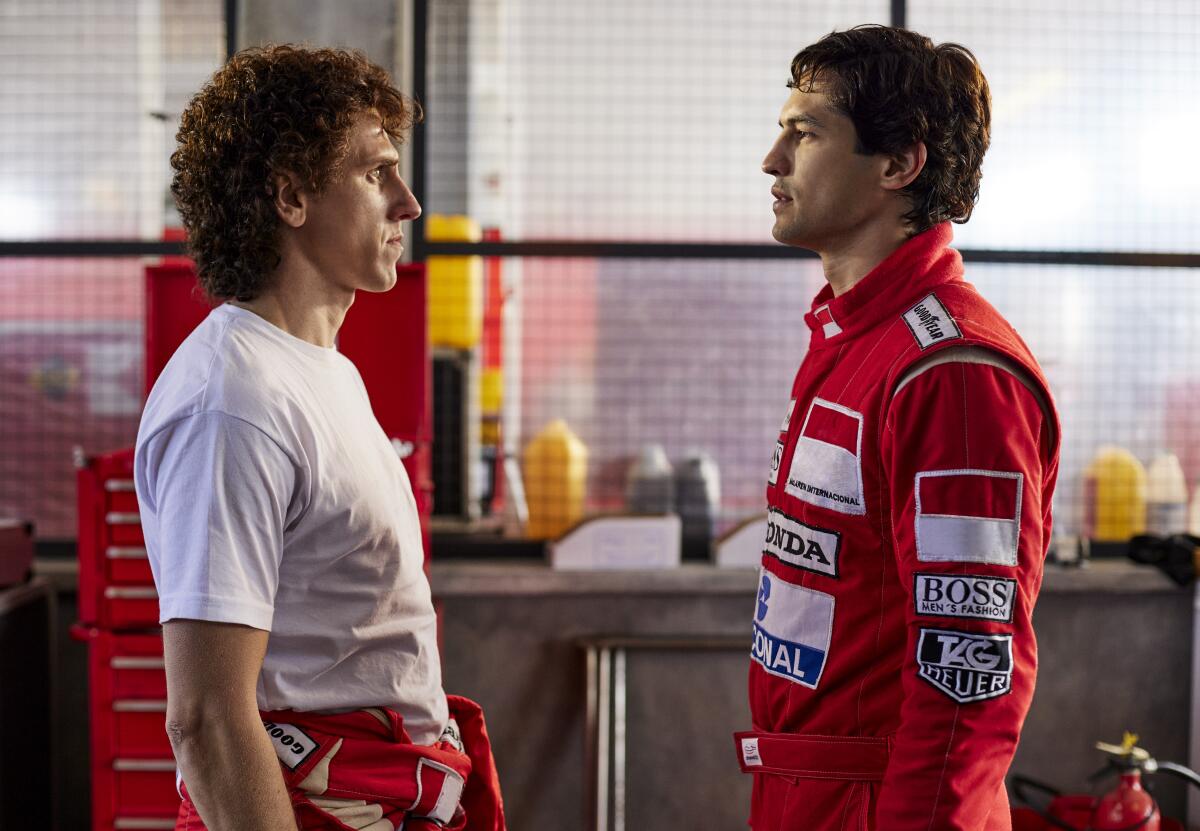Netflix helped bring F1 to new heights. Now the sport is poised to return the favor

A few seasons into the run of Netflix’s Formula 1 docuseries “Drive to Survive,” the racing league’s governing body, the Fédération Internationale de l’Automobile (FIA), presented the platform with a deck containing evidence of “the Netflix effect.” Since the series premiered in 2019 as part of a concerted effort to expand the sport’s footprint in the U.S., officials had seen social media engagement, merchandising, attendance and ratings for race telecasts improve in its least-penetrated major market.
“It’s tough to totally decouple — Formula 1 was doing a lot of great new stuff, you had a broadcast partner in ESPN that was also prioritizing it, and you had a partner in Netflix that was promoting the sport through the docuseries,” recalls Brandon Riegg, vice president, nonfiction series & sports, at the streamer. “But they for sure were very generous and said, ‘We attribute a lot of this to Netflix.’ And when you saw the gains that they made across many categories, it was impressive, and I felt like we could take credit for at least a portion of that.”
Now Formula 1 is poised to return the favor.
With the premiere Friday of “Senna,” a scripted miniseries about the life and career of Brazilian F1 legend Ayrton Senna, the championship’s rich lore — replete with archival footage and FIA authorization to reconstruct races, podiums, logos, uniforms and track layouts from Senna’s heyday — becomes the source material for yet another evolution in one of the most innovative relationships in sports entertainment.
‘Senna,’ which premieres on Netflix on Nov. 29, follows the life of the legendary Brazilian driver from his early days in karting to his tragic on-track death in 1994.
“It becomes almost like an origin story for F1,” says “Senna” showrunner Vicente Amorim. “You love ‘Drive to Survive’? You’re an F1 fan? You’re maybe thinking of watching the ‘F1’ movie next year? Maybe have a look at how it all started.”
If Warner Bros.’ 2025 feature, developed in collaboration with the FIA and starring Brad Pitt, represents the sport’s promotional campaign at the scale of a Hollywood blockbuster, “Senna” flows instead from Netflix’s distinct approach to international television. The six-part series, which follows its dashing hero from his karting days in São Paulo to his tragic death, at 34, during the 1994 San Marino Grand Prix, was produced in Brazil, filmed largely in Portuguese and relied on Latin American artisans, particularly in the creation of its astonishing replica cars. It’s the same regional model that created crossover hits such as “Élite” and “La Casa de las Flores,” applied to one of the most successful drivers in F1 history.
“We really made those shows thinking they would be huge in Spain and Mexico, respectively, and I think it’s precisely their authenticity and their very specific local value, culture, look and feel that made them unique for their own countries and then globally appealing,” says Francisco Ramos, Netflix’s vice president of content Latin America, who worked on both titles. “What we’ve discovered, through this journey of almost 10 years making local content outside of the U.S., is that the most accurate, authentic stories that properly represent the cultures from which they come are the ones that are able to find resonance outside of their home territory.”
Conceived by the racer’s family and Brazilian production company Gullane, “Senna” came to Netflix after plans for a feature film hit creative and financial roadblocks — and soon found a devoted fan in Amorim, who vividly remembers Senna’s zenith in the late 1980s and early 1990s, when he won three world championships. “It becomes almost like a religion,” Amorim says of growing up in Brazil during this period. “Every Sunday, you turn on the TV to watch Senna probably win.”
Although its focus is the triumph and tragedy of Senna’s career, as well as his relationships with his parents, Miltão (Marco Ricca) and Zaza (Susana Ribeiro), and his glamorous pop star girlfriend, Xuxa (Pâmela Tomé), “Senna” is also the tale of a fast-modernizing sport, one on the cusp of becoming the glitzy global juggernaut it is today. In 1994, the year Senna died, the F1 world championship consisted of 16 races, 11 of them in Europe; 30 years on, the season now spans 24 races on five continents, including three in the United States alone. And Senna himself — handsome, media savvy and impatient with the Old World politics he found in F1 when he joined the circuit in 1984 — was instrumental in setting the transformation in motion. As Amorim puts it, “There’s an F1 ‘Before Senna’ and an F1 ‘After Senna.’”

The makeup of the “After Senna” F1 fan base is, in fact, a significant part of why Netflix has invested so much in its partnership with the sport. Although the FIA first envisioned “Drive to Survive” as a way to reach American viewers, according to Riegg, Netflix saw the docuseries as a “hedged bet”: If it failed to catch on in the States, it still had potential in other countries where Netflix operates that had established F1 followings.
In the end, “Drive to Survive” boosted interest in F1 not only in the U.S. but also globally: When the FIA presented Netflix with its deck about the series’ impact, “They made gains in some of the markets they thought were the most mature, including Brazil and Italy and Spain,” Riegg says.
Although Ramos insists that “Senna,” which was first announced in 2020, was not expressly intended to “feed off” the success of “Drive to Survive,” in many ways it epitomizes the same effort to diversify output and audience that has defined Netflix’s business in recent years. The release of promotional art and the trailer for “Senna” attracted interest not only in Brazil but also in other F1 strongholds like Mexico, Argentina, Italy and Japan, while the docuseries might be said to have primed the pump for potential viewers in places like the U.S. that have a less established F1 following.
“During the process of getting this developed and made, ‘Drive to Survive’ became bigger and bigger,” Ramos says. “That’s not the way we planned it. ... But for sure there’s a benefit that I cannot steer away from.”
The benefit might also work in reverse, Riegg acknowledges, creating a chance “to broaden the funnel or the entry point for people that are going to become fans of Formula 1 in general, whether that’s the races or something like our documentary series.”
After a career-defining year that included battling through a midseason slump, Max Verstappen won his fourth consecutive Formula One title Saturday night.
It’s an opportune moment for Netflix’s relationship with F1 to evolve, as “Drive to Survive” confronts its first real headwinds after years of viewership growth.
“I think there’s been a stabilization of the viewership the last couple seasons,” Riegg says. “It did the first few seasons continue to grow consistently and — I guess ‘plateau’ is one word — then found its audience. There’s a natural ebb and flow on all of these shows, especially the sports shows, or even our dating shows, which is analogous in certain ways, where some seasons you just have stronger stories than others. I think part of what F1 deals with that’s somewhat different than some of the other sports is you’ve had a winner in Max [Verstappen] and a team in Red Bull that’s really dominated for many seasons in a row so there’s sort of been less suspense and perhaps drama over the course of the season.”
What’s not yet on the table for Netflix, Riegg emphasizes, is live Formula 1 racing, although the FIA’s current U.S. television deal, with ESPN, expires in 2025. And it’s not because of the challenges the platform has faced in scaling up its capacity for live programming, most recently during the boxing match between Jake Paul and Mike Tyson, which led to widespread complaints of freezing, buffering and poor image quality. It’s because Netflix’s current focus vis-a-vis live television is on one-off events, rather than on a season-long commitment. “We’re in the crawl, walk, run phase,” Riegg says. “We’re definitely not in that business right now.”
And as “Senna” itself understands, it’s commerce as much as horsepower that makes the wheels of the sport turn. “F1 is a business,” Amorim says, repeating a real-life line from Senna rival Terry Fullerton that’s included in the series. “Except for two hours on Sunday.”
More to Read
The complete guide to home viewing
Get Screen Gab for everything about the TV shows and streaming movies everyone’s talking about.
You may occasionally receive promotional content from the Los Angeles Times.









